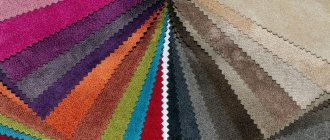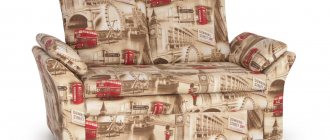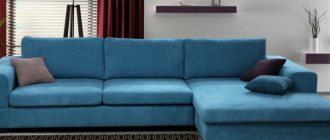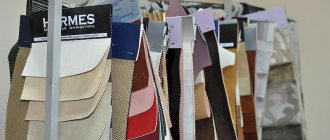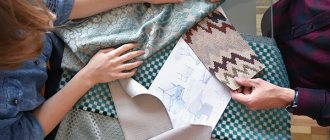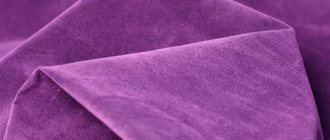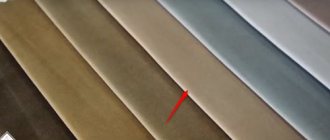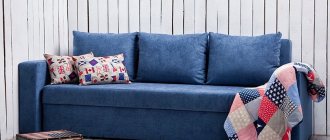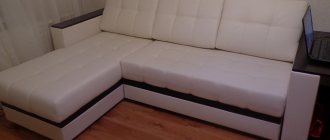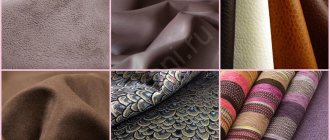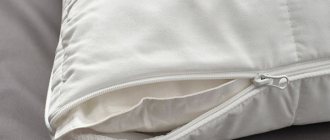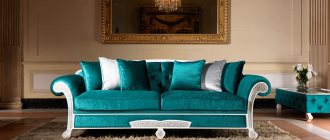Furniture chenille is a low-pile fabric characterized by an attractive appearance and a huge range of colors and textures. Its popularity is growing every year due to its reasonable cost. Even absolutely simple sofas made of chenille look expensive and are pleasant to the touch. But the performance characteristics of different types differ. The material can be endowed with the “anti-claw” property. There is waterproof and stain-resistant chenille. But here you need to take into account that along with quality, the price also increases.
What kind of fabric is chenille?
The name of the chenille fabric suits her very well. In French, "chenille" means "caterpillar". The structure of the thread resembles a small caterpillar. A strong, fairly thick thread runs through the center, barely visible behind the dense pile (yarn). Photo:
The yarn is woven into the warp during production. Combed fluffy fibers are placed around one or two threads, after which the workpiece is twisted, forming a thread with a dense fleecy structure. Next, fabric is made from chenille thread. The more threads the fiber is woven into, the denser and more wear-resistant it is.
Description of the fabric in the table:
| What is another name for the fabric? | chenille, furniture chenille |
| Natural or synthetic? | synthetic or blended |
| What does it look like, what does it feel like? | fleecy, soft, dense, textured, silky |
| Application | furniture, curtains, production of threads for knitting, warm clothes, home textiles |
| Fabric structure | satin, tapestry, twill, jacquard weave |
| Recommended cleaning method | dry cleaning, dry cleaning, cleaning with foam and special care products for upholstered furniture |
| Kinds | chenille jacquard, chenille corduroy, chenille taffeta |
Sometimes the fabric is called “furniture chinil”. This spelling is erroneous. The correct name for the material is chenille.
Description of chinilla woven
When trying to find a “description of woven chinilla,” difficulties may arise because many do not know how to correctly write “woven” or “woven.” To find out, you need to look in the dictionary. For example, in Ozhegov’s Explanatory Dictionary, where it is written: “ WOVEN - Made, made on a loom. Woven bedspread. Woven patterns."
Shinille is a soft, durable material reminiscent of velor. It has good wear resistance. It is produced on special machines. The fabric is dyed either ready-made or made from pre-dyed threads.
There are different types of fabric weaves. They can be satin, tapestry or jacquard. The main secret lies in the structure of the thread. The jacquard type is the most beautiful. Wonderful ornaments made of multi-colored threads in combination with a velvety texture look aristocratic and elegant. This fabric is ideal for furniture.
Composition and properties
In the manufacture of chenille, various materials are used, including cotton. The fabric contains viscose, acrylic, and polyester. However, most often a completely synthetic version is used for furniture upholstery.
Chenille upholstery for furniture with a composition of 100% polyester is usually found on sale.
- Synthetic chenille is durable, stain-resistant, water- and light-resistant. But at the same time, it may not be very pleasant to the touch, become electrified and cause discomfort in the heat. Made from polyester (sometimes mixed with acrylic).
- Natural chenille. To produce furniture upholstery, polyester is mixed with cotton fiber. The composition may contain up to 60% cotton. This fabric is hygienic, very pleasant to the touch, and does not electrify. But in terms of durability and wear resistance, it is significantly inferior to its synthetic counterpart.
- A polyester/cotton/viscose blend is often the best option. This chenille is quite comfortable and durable.
Velor or matting?
Matting is a durable natural material, consisting of 100% cotton, linen or wool threads. It has a rough texture, looks like burlap, and does not wrinkle. The advantage of this option is the budget cost. The matting fits organically into the interiors of ethno- and eco-styles.
This type of upholstery, unlike velor, is not suitable for formal interiors and does not withstand the claws of pets at all. To remove stubborn stains, you can use a sponge lightly moistened with soapy water. Basically, matting, which does not tolerate moisture and cleaning agents, is used in rooms where there are no pets or small children.
Characteristic
The characteristics of the material depend on the density, weave, and composition. Indicators of the average chenille:
- density –320-400 g per square meter;
- Martindale test - 30-40,000 cycles;
- light resistance – excellent;
- wear resistance – good to excellent;
- fabric width – 140 cm.
Note. The Martindale test shows the abrasion resistance of furniture fabrics. The standard for furniture is 20 thousand cycles.
Photo gallery
Fabrics for dolls Fabrics for upholstery of sofas Fabrics for upholstery of chairs Fabrics for upholstery of chairs Fabrics for shoes Fabrics for blankets Fabrics for bedspreads Fabrics for sewing toys Fabrics for curtains2017-09-24
Tags: Fabrics for dolls Fabrics for upholstery of sofas Fabrics for upholstery of armchairs Fabrics for upholstery of chairs Fabrics for shoes Fabrics for blankets Fabrics for bedspreads Fabrics for sewing toys Fabrics for curtains
Back Polyamide
Forward Twill (Twill)
You might be interested
Application area
Chenille is used in a wide variety of fields. It is made from:
- yarn for knitting bulky items:
- warm clothes (sweaters, dresses);
- blankets;
- towels;
- cleaning wipes;
- carpets;
- furniture upholstery;
- curtains, curtains.
The ability to combine different types of fibers (artificial and natural), variations in density and type of weaving make chenille a very versatile material.
Reviews
“We bought upholstered furniture covered with chinoiserie fabric ten years ago. The furniture has gone through several moves and renovations, but it is still in good condition. I clean it if necessary with a special stain remover. Does not absorb odors and dirt. But puffs may appear if there is a cat in the house.”
Vladimir
“Chenille is a gorgeous fabric for upholstery, but it’s not at all practical. Furniture that requires only dry cleaning is only suitable for an office. But when there are children, stains and dirt cannot be avoided.”
Elena
“I liked Chinille. I have a sofa and chair upholstered in this fabric and they look great. Yes, the fabric is durable and does not absorb odors. But it requires careful handling. The fabric does not like water and is susceptible to puffs.”
Olga
Originally posted 2017-12-21 07:19:14.
Advantages and disadvantages
Furniture with chenille upholstery often looks expensive and noble. Chenille has many advantages:
- attractive appearance;
- acceptable price;
- rich palette of shades;
- large selection of textures;
- softness, pleasant tactile sensations;
- retains color well, does not fade, does not fade;
- wear-resistant;
- lasting;
- holds its shape well.
But it was not without its drawbacks:
- natural material absorbs water and quickly becomes dirty;
- needs regular care, capricious;
- most often does not have an anti-claw effect and is susceptible to snags;
- may become electrified and cause discomfort in the heat;
- accumulates dust.
Chenille for a sofa has approximately equal pros and cons. The material is not very practical and hygienic, but many are ready to forgive its shortcomings due to its beautiful appearance, durability and reasonable price.
Velor or flock?
Flock is a non-woven material made from synthetic fibers - acrylic, nylon, polyester. Outwardly, it imitates expensive fabric, but in fact belongs to the budget price category. It is characterized by:
- strength, resistance to animal claws;
- moisture resistance - any stains can be washed with alcohol-free detergents;
- UV resistance.
Disadvantages of flock: weak antistatic properties, which means attracting dust and dirt, absorbing foreign odors. Expensive and high-status velor is more suitable for expensive interiors; practical and cheap flock is more suitable for children's rooms and verandas.
Rules of care
When choosing a sofa with chenille upholstery, you should be prepared for regular maintenance. In order for the fabric to maintain its softness and impeccable appearance, you must follow the following rules:
- Vacuum your sofa at least once a week.
- Wash upholstery with special products for upholstered furniture and carpets.
- Do not wet the fabric. Cleaning is carried out with a slightly damp lint-free cloth or a soft brush.
- Grease stains can be removed using ammonia diluted with water 1 to 3.
- If the sofa is heavily soiled, you should contact a dry cleaner. Do not use bleach, solvents, or any aggressive agents to remove stains.
Advantages
This material has a large number of valuable properties:
- does not allow light and noise to pass through;
- does not absorb odors;
- soft and elastic;
- no tendency to shrink;
- a huge assortment of all kinds of colors, different patterns and textures;
- durability;
- strength;
- wear resistance;
- does not fade over time;
- does not cause allergies;
- soft, velvety structure;
- natural chinilla is hypoallergenic and environmentally friendly;
- it is more affordable than popular upholstery materials, but is not inferior to them in beauty.
Shinille is a practical material that, with good care, will last for many years without losing its qualities.
Features of choosing a sofa with chenille upholstery
When choosing chenille upholstery, you need to consider the location and purpose of the sofa. The required composition of the material depends on these factors. Acrylic and viscose fabrics can withstand heavy loads, while cotton fabrics are the most pleasant for daily use.
Cotton upholstery will also add comfort and coziness to a home sofa due to the fluffy thread, and synthetic inclusions will extend its service life. Chenille can give an old home sofa a second life, since using it as a new upholstery for reupholstery is the most successful choice. It is quite elastic, moderately stretchable, effective and practical.
When choosing chenille upholstery, you should pay attention to the composition, class of material, as well as the country of origin. Of course, the highest quality options will cost accordingly, but this investment will by no means become useless. A sofa with a beautiful appearance will be an ideal element in the interior for a long time, which will not require repair or replacement.
Colors
The rich range of colors is one of the most important advantages of this fabric. Among the most popular colors and shades are the following.
- Blue and light blue. The variety of shades in this range allows you to choose upholstery from light blue to deep royal blue.
- Green. Monochrome or patterned green chenille looks expensive and respectable.
- Brown . A noble and discreet brown sofa is an interior classic.
- Grey. Another neutral, discreet shade, noble and spectacular at the same time.
- Violet. The mysterious palette will add an expressive and eye-catching touch to any design.
It is very important that the color of the sofa does not contradict the composition as a whole, but fits into it organically. In addition, the color scheme must fully match the style of the room.
